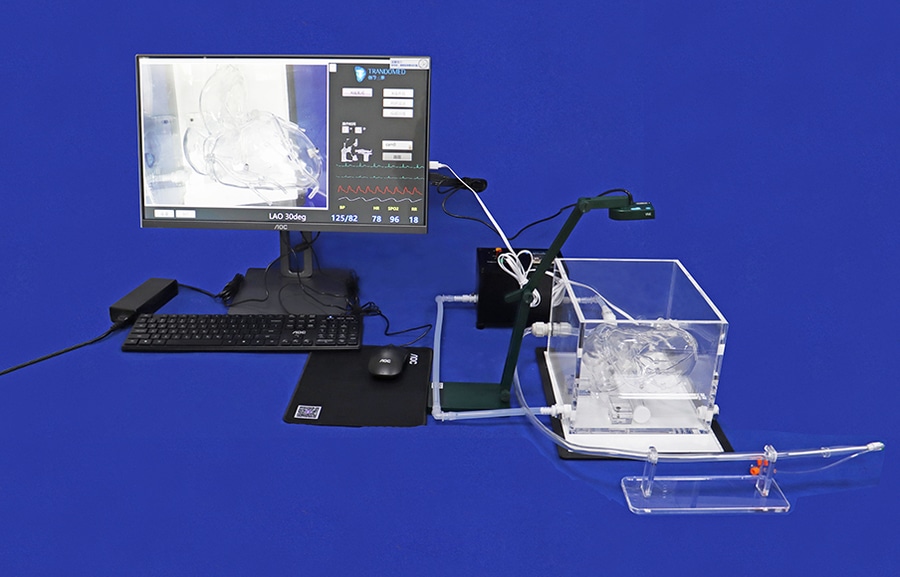
#Industry News
Percutaneous Coronary Intervention (PCI)
PCI Training Simulator
Percutaneous coronary intervention (PCI) includes percutaneous transluminal coronary angioplasty (PTCA) with or without a stent. The main indication is the treatment of
*Angina (stable or unstable)
*Myocardial ischemia
*Acute myocardial infarction (especially if cardiogenic shock is developing or has occurred)
optimal treatment for transmural ST-segment elevation myocardial infarction ( STEMI ). Elective PCI is suitable for patients who have recurrent angina pectoris after myocardial infarction (MI) or can induce angina before discharge, and for patients with angina who still have symptoms despite drug treatment.
Percutaneous transluminal angioplasty (PTA) may also be used to treat peripheral artery disease .
Steps
PTCA is performed by puncturing the femoral, radial, or brachial arteries. The radial approach is increasingly used because it reduces patient discomfort, shortens postoperative bed rest, and reduces the incidence of complications (eg, bleeding, pseudoaneurysm formation).
A guide catheter is inserted through the large peripheral artery to the coronary artery opening. Under the guidance of X-ray fluoroscopy or intravascular ultrasound, a catheter with a balloon on the tip is sent to the stenosis, and then the balloon is inflated to crush the atherosclerotic plaque and expand the artery lumen. Coronary angiography was performed again after PTCA to record the changes that occurred. PTCA can usually be performed on 2 to 3 blood vessels as needed.
Coronary stents are expandable wire mesh cylinders that help keep narrowed areas open. Brackets are most useful when:
*Coronary stents are expandable wire mesh cylinders that help keep narrowed areas open. Brackets are most useful when
*Short lesions of larger native coronary arteries without previous PTCA
*Focal lesions in saphenous vein grafts
Treatment of Acute Vascular Occlusion During PTCA
Stents are currently widely used in acute myocardial infarction, ostial or left main lesions, chronic total obstructive lesions, and bifurcation lesions.
Bracket type
Bare metal stents (BMS) are made of Nitinol. Drug-eluting stents (DES) combine drugs (such as first-generation drugs: sirolimus, paclitaxel; second-generation drugs: everolimus, defosolimus, zotarolimus) on the metal stent to inhibit Neointimal proliferation to reduce the risk of restenosis. Radioactive stents or intraluminal radiation within coronary stents (brachytherapy) using radioactive particles have not been shown to be effective in treating restenosis. Biodegradable stents are in development and are currently limited to clinical trials.
Anticoagulation and related treatments
Various anticoagulant and antiplatelet regimens are used during or after angioplasty to reduce the incidence of thrombosis at the balloon dilatation site. In patients with unstable non-ST-segment elevation myocardial infarction, ticlopidine, clopidogrel, and platelet glycoprotein IIb/IIIa inhibitors are standard treatments. To reduce the risk of stent thrombosis after PCI, thienopyridines (usually in combination with aspirin) are continued for at least 9 to 12 months until the stent has endothelialized. Calcium channel blockers and nitrates may be used to reduce the risk of coronary artery spasm.
Relative contraindications to PCI include
*Coagulation disorders
*A single diseased vessel supplying the entire myocardium
*Severe stenotic disease of the unprotected left main trunk, lack of blood supply from its own side branches or past bypass side branches in the left anterior descending artery
*Diffuse disease without circumscribed stenosis
*hypercoagulable state
*lack of cardiac surgery support
*<50% stenosis
*complete blockage of coronary arteries
Although PCI is sometimes considered absolutely contraindicated in the absence of cardiac surgical support, many experts advocate that when revascularization is urgently required in STEMI, PCI should be performed by experienced operators in an approved cath lab even in the absence of surgical support.
Although bypass grafting is the preferred option for unprotected main disease, PCI is becoming more widely used in certain populations.
The main complications of PTCA and stent implantation are
*arterial dissection
*Bleeding due to antithrombotic therapy
*restenosis
*Standard Cardiac Catheterization and Coronary Angiographic Complications
*Thrombosis and Distal Embolism
Among all angiographic procedures, PCI carries the highest risk of contrast nephropathy (related to the amount of contrast agent and operation time). Patients with existing renal insufficiency should be hydrated before surgery, use non-ionic contrast agents or Hemofiltration can reduce the risk.
with coronary angiography without angioplasty or stent placement.
Post-PCI mortality is related to patient conditions and physician operating techniques. The constantly revised scoring system can help doctors determine the risk of death after PCI and can also provide assistance in counseling the pros and cons of two treatment options (PCI vs. medical therapy).





